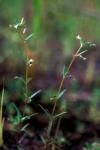Latin name
Hedyotis corymbosa (L.) Lam.
Family
Rubiaceae
Common name(s)
Flat top, mille graines (Fr.)
Synonym(s)
Oldenlandia corymbosa L.
Geographical distribution
South and Southeast Asia: Bangladesh, India, Indonesia, Philippines, and Thailand
Rest of the world: New Guinea, Niger, Nigeria, Senegal, Sudan, Suriname, Uganda, West Africa, and Zimbabwe.
Morphology
A slender, erect or spreading, 5—60—cm—long annual herb.
Stem: straight or zigzag, hairless, and 4 angled.
Leaf: short petiole, narrowly lance-shaped, margins are without teeth, and with hairless surfaces.
Inflorescence: 2—8 flowered cymes borne in axils of leaves; corolla white or very pale purple.
Fruit: capsule, 1.8—2—mm—long, crowned by calyx lobes; seeds numerous, oval, angular, brown, 0.3—mm—long.
Biology and ecology
Found in open waste places, upland and rainfed lowland rice fields, and gardens; flowers throughout the year.
Agricultural importance
A common and widespread weed in rice under both lowland and upland conditions though rarely causes serious losses.
Management
There is little information available on control and management.
Cultural control: hand weeding and tillage are effective means of control.
Chemical control: no information available.
Selected references
Chao J. Rubiaceae. Flora Taiwan. 4:247-346.Moody K. 1989. Weeds reported in South and Southeast Asia. Manila (Philippines): International Rice Research Institute. 440 p.Moody K. 1992. Weeds of cropped areas in the Philippines. Philipp. J. Weed Sci. 19:31-78.Pablico PP, Moody K. 1986. A dry season lowland rice (Oryza sativa) weed survey in Central and Southern Luzon, Philippines. Philipp. J. Weed Sci. 13:39-49.Soerjani M, Kostermans AJGH, Tjitrosoepomo G. 1987. Weeds of rice in Indonesia. Jakarta (Indonesia): Balai Pustaka. 716 p.Hedyotis corymbosa (L.) Lam. Global Compendium of Weeds home page (www.hear.org/gwc/html/index.html).
Contributors
JLA Catindig, RT Lubigan, and DE Johnson
